Mr. Birol welcome to the Diskusari website. First discus association in Croatia.
 Can You introduce yourself to members of Diskusari
Can You introduce yourself to members of Diskusari
I was born in Ankara, Turkey in 1957. I have been an aquarist for more than 45 years and nearly 30 of those years were with Discus. I am one of the founders of the Turkish Discus Society and the President of this Club at the time being. I also own and administer the largest Discus group on Facebook with over 12,000 members now.
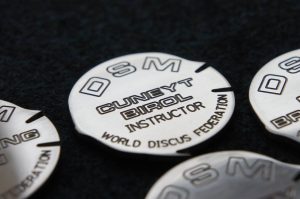 I completed the Discus Club (Singapore) Discus Judge Training Course in 2009 and is one of the certified judges of DCS. Till today, I judged at more than 25 Discus Championships Worldwide. I also took part in the 2nd & 3rd Discus Congress organized by Napoli Aquatica in 2011 and in 2013, and also attended a Discus Congress in Poland. I gave lectures about discus on various countries and also started giving a Discus Judging Course together with Jeffrey Tan lately.
I completed the Discus Club (Singapore) Discus Judge Training Course in 2009 and is one of the certified judges of DCS. Till today, I judged at more than 25 Discus Championships Worldwide. I also took part in the 2nd & 3rd Discus Congress organized by Napoli Aquatica in 2011 and in 2013, and also attended a Discus Congress in Poland. I gave lectures about discus on various countries and also started giving a Discus Judging Course together with Jeffrey Tan lately.
Besides keeping Discus, I am a serious collector of seashells and fish paintings.
I also love keeping dogs and also judged on various dog competitions in Turkey.
I have two sons and I am proud of them.
We can see you on many discus shows like one of the main judges. What was the greatest show that you participated?
It is difficult to choose only one Show. Duisburg was the greatest discus show of all, but unfortunately it is gone now. NapoliAquatica and Aquarama are the most professionally organized shows in my opinion. However, if we look at the shows organized by discus clubs, Nordic Discus Society (Sweden)and BIDKA (United Kingdom) organizes the best ones.
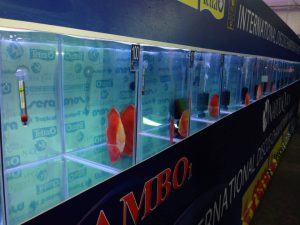 What is important things to organize one contest?
What is important things to organize one contest?
There are many important parameters in organizing a contest. I beleive finance is the most important one. If you do not have enough sources or sponsors, there will be no show. To find good, reliable sponsors is of utmost importance.
Second and maybe almost as important as finance is to have a very good Team. When it is show time, you need many qualified personel to keep things going smoothly. If you think you do not have enough people, you should not attempt to organize a show. Especially you must at least 2-3 people who have good knowledge of water preparation, hygine, rules of the championship, classes and varieties of discus and who can differenciate a sick fish from a heathly one. If it it designed to be an international show, you must have enough personel who speaks foreign languages to help and guide the foreign guests and visitors.
Good planning ahead of time is also necessary. If you want many people to attend a show, you should start to announce and publicize it one year before the show date. In promoting the show, web sites and internet should be given very much attention, as well as local publicization using posters, pet shops and clubs. Also you should make sure that there are no shows or aquarium fairs at the same dates. Climate of the country effects the number of visitors so the best time of the year for favoriable weather conditions should be set as the date of the show. Choosing the venue should be an important part of the planning. The venue should be easily accessed by public and private transportation, should be near to the airport and the train station if possible, should not be far away from the show hotel. Water and electric supply and security of the venue should also be taken into consideration. An electric failure can cause a big disaster during the show.
There are many other parameters which should be also considered but if we cover them all, this interview will turn into a book.
 When keepers bring their fishes on show what is your advices, how they must prepare fishes for show?
When keepers bring their fishes on show what is your advices, how they must prepare fishes for show?
In fact preparing the fish should start maybe months ahead of the show. Some fish breeders and keepers in Asia choose and start to raise their show fish when they are just a few inches long and grow them with special attention.
It is a must to start with a fish in full health. Most people deworm their fish regularly for both internal and external parasites to have them in top condition at the show.
You should seperate your show fish from the community tank and put it into a tank similar to show tanks all by itself (breeding tanks are very good for this purpose) so that it will not feel alone or scared when you transfer them into the show tank.
This „preperation tank“ should be placed in the most crowded place in the house or the shop where fish can see many people as possible and get used to be visited by crowds. Jason Wu, who is very successful in showing fish has got a big tank standing right on the floor of his living room where he keeps all his show fish. He also have 3 cats who chase and try to catch these fish all the time, therefore, the fish got used to being treated like a pray and do not care about whatever conditions they meet during the show. J
You must feed your fish a very small piece of food every time you get close to the tank so that it will get used to expecting some food whenever people come nearby. This will make your fish people friendly which is very important with the show fish. You should also expose your show fish to noise, bright light, flash of your camera from time to time so that it will get used to the show conditions. You should also make frequent water changes with slighly different parameters like temperature, hardness and PH than the fish are used to. This will help the fish to adjust to water in the show tanks easier and faster.
It is a good practice to learn the water parameters of the show tanks from the organizer at least one month ahead of the show if possible, so that you can start acclimatization of your fish when you are still at home by changing the PH and hardness little by little to reach the show parameters. This might get very important sometimes like at the latest show of NADA we had in Texas; where the PH was around 8.5!
You should stop feeding the fish at least one day before transporting the fish to the show. I know that some breeders who stop feeding the fish three days before the show. It helps you to carry the fish without the water getting polluted on the way and also the show tank does not get dirty with feces. Besides that the hungry fish comes to the front of the tank more eagerly in search of food. You can carry your fish in a bag filled with water and oxygen if the distance is not very long. Always put a mixture of tank water and conditioned fresh water into the bags. Most breeders also put a mild tranquilizer to confort the fish and to slow down breathing and some of them also add some antibiotics to the water to help with minor injuries which might happen during transportation. While transporting the fish take into consideration what the weather parameters are.
Try to reach the show venue at the earliest possible time, which is whenever the bench-in starts. Early benching-in gives more time to the fish to get used to the conditions of the show tank and it will display better during judging. Take your time to acclimitaze your fish. The slower you mix the tank water with the water of the bag the better. A good practise is to syphon the tank water to the bag with a tiny air hose. If you are used to it, use your hands instead of a net when transfering the fish. It minimizes the risks of injury. Be very careful about not to use any equipment with your fish that has been used by other competitors before to avoid cross-contamination. Try not to splash any water to other tanks and also be very careful that water from other fish is mixed in any way with your water. It is a good practice to carry a hand-disenfectant with you and also if you have to share any of the equipment, a strong PP solution is a great aid. Cover your tank very tightly and do not let anybody else to touch your fish or tank water.
When you return home with your fish after the show, quarantine your fish for as long as possible, at least for two weeks before transfering your fish to your community tank. During this time observe your fish very closely and carefully and use medication if necessary. This is very very important.
Can you explain us how does judging clasification looks like?
In nearly all discus shows fish are classified according to Phenotypes. In other words not according to their genetic (Genotypes) traits but according to their appearance or their physical characteristics like color and pattern. The number of classes usually varries according to the rules set by the organizer and also according to the number of fish that enter the competition. If you have a competiton with only 50 fish, there is no meaning at having ten different categories. If we have inflation of catagories, it may mean that there will be only a few fish in each category and therefore most of the fish will be automatic winners which should be avoided. In my opinion to have a seperate catagory, there should be at least five fish competing in that class. To give an example lets say there are 4 blue solid and 3 red fish in a competition. In such a case, to have a Reds and a Solid Blue category is meaningless. Instead there sould be only one catagory to cover them both.
During the first Discus Congress at Napoli Aquatica at 2010 participants signed underneath the catagorization which was suggested by Mr. Heiko Bleher. This catagorization was as follows:
WILD FORMS:
- HECKEL;
- BROWN;
- BLUE;
BREEEDING FORMS
- STRIPED TURQUOISE;
- SOLID BLUE;
- RED;
- YELLOW;
- PATTERN FINE;
- PATTERN COARSE;
- SPOTTED;
- ALBINO (eventually solid and patterned);
Organizors in many of the shows try to apply these classes now, making modifications according to their needs. For example, to have four Wild classes is not necessary on most of the shows because of the number of the fish entered are usually not enough to make such a diversification.
This classification has also proven to be insufficient in some shows like the ones we have in Asia, where Pigeon Bloods are an important mutation. Under this classification, a Pigeon blood discus have to compete with a Coarse Patterned Turquoise fish or a Fine Patterned Snake Skin which are totally different fish in their outer appearance as well as their Genetics.
For a show with limited number of fish, lets say up to 70 fish, I advise to have a basic catagorization like:
- Solids
- Stripped
- Spotted
- Patterned
- Unclassifiables
- Wilds
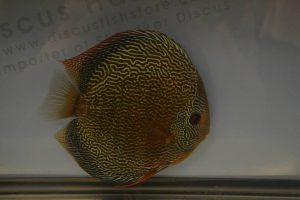
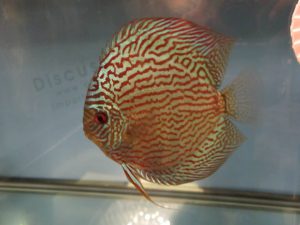
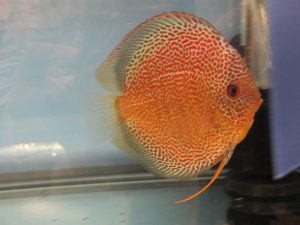
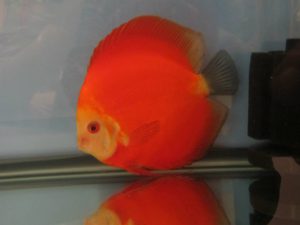
This catagorization is good enough to cover the needs of a small to medium sized shows.
In some countries classes are exaggerated in numbers like in Singapore thet might have up to 13 classes and in some countries like Belgium it is over-simplified. They have only 3 classes. They are: Classic Hybrids, Modern Hybrids and Wilds.
As a general rule, a fish that competes should be mature and in adult size. However, lately we have seen in Singapore and Malaysia classes for just juvenile fish to encourage good and healthy raising of young fish. In Britain and in Sweden, we also have “Challenge” type of additional compettions where 5-6 different hobbyist are given 6-8 small fish each, from the same batch of fishes and they try to grow these fish to the best size, colour and shape in a given period of time like 6 months.
What is important with judging discus fish?
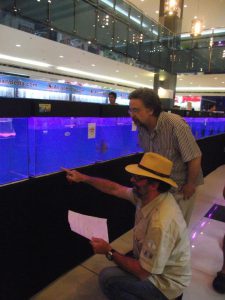 Explaining how to judge fish is a complex and complecated process. I don’t think it can be explained in a detailed way in an interview. However ı will still try to explain the major points to help the discus keepers to have a better understanding of what the judges do.
Explaining how to judge fish is a complex and complecated process. I don’t think it can be explained in a detailed way in an interview. However ı will still try to explain the major points to help the discus keepers to have a better understanding of what the judges do.
In judging discus what we seek is a discus which looks almost perfect. This is an objective usually very hard to achieve, if not impossible. There are always some kind of faults on each fish. Looking at these faults help us to differentiate a show winner from a not so good looking fish. However our objective should always be choosing the healthiest, most lively and best looking discus.
We can divide the faults that we look at into two groups. These are the Major Faults and the Minor Faults. Major faults require us either to disquilify the fish or to penalize the fish eavily by deducting high points while scoring. We can summerize the major faults as; Sick fish,Swimming problems,
Deformed body, Crooked rays, Deformed fins, Unequal paired fins, Uneven eyes/Iris
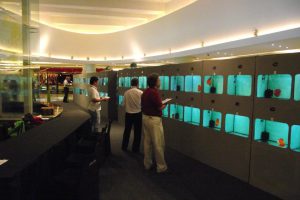 Gills Cover (Operculum) Problems and Caudal Fin (Tail) Problems and Deformities. Minor faults are faults on the fish which are of a lesser importance that cause us also to deduct points but to a lesser degree than the major faults. These can be listed as, Blemishes over body, Notched /Kink forehead, Red nose, Cloudy cornea and Hormones & Colour-enhancers
Gills Cover (Operculum) Problems and Caudal Fin (Tail) Problems and Deformities. Minor faults are faults on the fish which are of a lesser importance that cause us also to deduct points but to a lesser degree than the major faults. These can be listed as, Blemishes over body, Notched /Kink forehead, Red nose, Cloudy cornea and Hormones & Colour-enhancers
What are judges looking on fish to give a mark?
We have the judging criteria to give marks to each fish while evaluating and also help us to be more objective while judging. If we really stick to these criteria and give marks accordingly, judging very seldom goes wrong. The criteria used in different competitions might vary from one show to the other but usually they are as follows in general :
Overall Impression
Overall impression refer to first impression when viewing at the discus at a glance. The fish must be healthy look, active, in good proportion, attractive color, pattern and uniqueness for the unclassifiable category. İn this part of criteria, sometime judges may overlook some minar fault of the fish. So the judges may have second opinion after discovered the minor fault that slip his eyes on the first impression.
Body Size
Body size play a very important part in most of the international show. Most show have stated a minimum size requirement for the fish entered in the show. Commonly set as 10cm as the minimum size requirement. This criteria is with measurable scale, so it is not so difficult to judge.
Overall proportion
Overall propotion of the fish in terms of body size, head part and all the fins in the perfect balance that contribute to the overall hormony look. This is another criteria that are subjective. One must be knowledgeable to know the perfect % sizes of each part of discus. Overall the fish must looks round as the name “Discus” given means “Round”. The dorsal and anal fin must be able to blend into overall shape to promote the overall roundness of the fish. The head should be in the good curve to blend in the fin’s curve too.
Fins / Tail
The perfectness of the overall fin proportion is the important factor in this criteria.
Dorsal fin, the spinous dorsal fin should be smoothly blend in the curve line from the head part, and in smooth curve into soft part of dorsal fin.
Anal fin should have the same characteristic in promote overall curve of roundness of the fish.
Caudal fin should be with straight spines, wide and fully open, there should be minimum gaps between dorsal, anal and caudal fin.
Pelvic fin should be open nicely and same lenght in pair.
Pectoral fin should be in perfect shape, the spines should be strainght and widely open.
Head / Gill / Scale
Head should be smoothly rounded and proportion into overall body shape roundness, both side gill plate should be fully cover the gill, scales should be in the proper direction. Any distorted arrangement of scales consider defect.
Eyes
Eye of a discus should be in proportion to the body size, the propotion in this related to the age of the fish. Certain size of fish with certain size of eye may indicate if the fish grow up normally or it is consider stunted in growth. İt carried 8% weight in total score.
Eye color is always in the debate in this criteria, some European shows do emphasize the red color eye as most preferable feature, but some people do not  agree. The criteria by Duisburg show do emphasize the red color eye as prefered feature except for the Heckel in wild category which eye should be black in the criteria for it’s category. However, in the opinion of most breeders and judges, red eye still the preferable feature for the beauty feature of a show fish. Eye of discus have various colors like red, yellow/orange, grey, etc. Judging on this criteria should be based on the overall proportion between eye size and body size, brightness of the eye color, perfect round eye without any chipping.
agree. The criteria by Duisburg show do emphasize the red color eye as prefered feature except for the Heckel in wild category which eye should be black in the criteria for it’s category. However, in the opinion of most breeders and judges, red eye still the preferable feature for the beauty feature of a show fish. Eye of discus have various colors like red, yellow/orange, grey, etc. Judging on this criteria should be based on the overall proportion between eye size and body size, brightness of the eye color, perfect round eye without any chipping.
Body Markings:
Body markings means the pattern coverage of the discus. Body marking in solid color category mean the solidness of the color coverage, considering the color is the marking color. So pattern on fin, head or body will be considered as disadvantage points.
As for the patterned fish , this criteria is split into two parts, which are: Attractiveness of pattern and the Uniformity of pattern.
Color
Color refer to the pattern color and base color of the fish. In discus, there are two layers of color on the fish, primary color which we refer to as base color. Pattern or stripe color is refer to as secondary color layer. Base color is the color of the inner layer of the fish color. For example on a the red turquoise, the red colour represent the base colour and the blue/green stripe of pattern colour refer to secondary color.
This criteria is to judge by the brightness, intensity and the contrast level between the primary and secondary colors of the fish.
How many judges is minimum for contest, and why?
 All the judges are human beings and we all have our personal preferences. For example, I love Red Turqoise more than other varieties. Also, I have not met one judge till today who is especially fond of Pigeon Bloods. I beleive it is a good example to say, I have never seen a Pigeon Blood chosen as Grand Champion in none of the championships that I attended.
All the judges are human beings and we all have our personal preferences. For example, I love Red Turqoise more than other varieties. Also, I have not met one judge till today who is especially fond of Pigeon Bloods. I beleive it is a good example to say, I have never seen a Pigeon Blood chosen as Grand Champion in none of the championships that I attended.
When giving the Discus Judging Course I named this phenomenon as the „Subjectivity Factor“. When judging fish, we have to try to eliminate this factor as much as possible. We can do it in two ways. One is to have standardized judging criteria and judging weights in all the shows and the second one is to have as many judges as possible.
For me the number of judges should at least be three. To have an odd number is good and might be necessary when voting for a Grand Champion. Choosing the judges is also very important. A judge who tries to impose his opinions to the other judges should be avoided. Each judge should respect each other and also the rules of the championship. Judges who are affiliates of a competitor should also not be choosen as a judge. I think I should not even mention that a judge should not be judging his own fish in anyway. J
When all marks from judges are collect, how they give final mark and decision of winner?
While judging each judge should evaluate the fish seperately. After the evaluation is finished, the organizer collects the results and adds them up to determine the winners of each catagory. Sometimes two fish can get the same score. When such a tie occurs, the usual practice is to call all the judges together to evaluate which fish should take the higher position.
For choosing the Grand Champion the common practice is to inform the judges the fish which won in each class and ask them to vote for their Grand Champioon among those winners. If the GC can not be choosen by the votes (e.g. Each judge have choosen a different fish) then the organizators may ask the judges to choose the best fish in the show together. Another method of choosing the Grand Champion is to look at the scores each fish has been awarded and the one which gets the highest points is the Grand Champion.
Which breeder or keeper took most awards in wilds and tank breed categories?
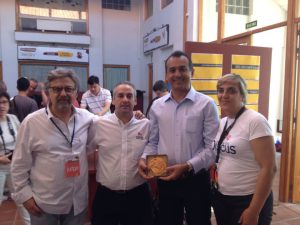 With the wild fish it is not easy to say just one name but I can easily say that wild fish exported by Hudson Crizanto, HEK-Discus won the most awards lately in nearly all the shows.
With the wild fish it is not easy to say just one name but I can easily say that wild fish exported by Hudson Crizanto, HEK-Discus won the most awards lately in nearly all the shows.
With the tank-bred catagories I can say that we have a domination of Malaysia. Even they may enter the competitions under different names, IP Discus,Tony Tan-Jeffrey Tan and Ricky Lim are the winners of most of the trophies in nearly all the shows.
On which project are you most proud?
In fact I have two projects which are still babies right now that I will most probably be proud of when they are finished.
First one is the World Discus Federation (WDF). It is a project that I have been working on for more than a year together with Jeffrey Tan. . We still did not make the official announcement of the WDF because I am still working on the constitution and the structure. It is not an easy process and it takes time. Discus Clubs from different countries and Show organizers are our founder members and most of the Clubs already decided to take part in the Federation. However there are different kinds of memberships which will help us to enroll people from countries that are not members of a Club or an Organization. WDF will work on setting standards for Discus varieties, work on standardizing the rules and classes of Discus Championships and also will help to educate serious discus keepers and also judges for the Shows. In fact, we already organized two International Judging Courses so far, one in Malaysia an done in Spain. You will hear about the Federation more in the near future.
My second project is www.discuspedia.com. It will be a web site where we will be able to gather all kinds of information about discus. Its software is similar to Wikipedia therefore anybody who wants to contribute will be able to add the information he wants to. Web sites backbone is ready and it is already online. My objective is to be able to gather all the possible information about our hobby under one roof. It will be the main source of information about discus when it is finished.
In your opinion, which is the largest discus exhibition in the world currently ?
Duisburg World Discus Championship was unquestionably was the biggest and the best exhibition. It is sad that it is not organized any more and it is history now. At the time being we have som shows which are competing to be the largest discus exhibition. For me the biggest candidate is NapoliAquatica. Nordic Discus Show also comes right after it. However, European Discus Championship which is held in Dortmund also have a big potential to become the largest discus exhibition in the long run because of its location and management.
Do you have some plans for future which is based on discus fishes, maybe some book?
In fact project like World Discus Federation and Discuspedia are project which will definetely extend to the future.
Writing a book is something that I also have in mind. I am already taking notes and writing whatever comes to my mind which might be interesting to take place in a book. Time will show. J
Thank you for doing this interview. Keep up a good work that you are doing and we will be honored if you accept a honorary membership in Diskusari.
I should be the one to thank you for helping me to reach and share my ideas and my knowledge with the discus lovers in Croatia.
Membership in Discusari will be an honor for me. Thank you again.
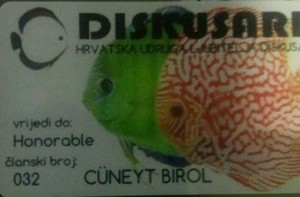
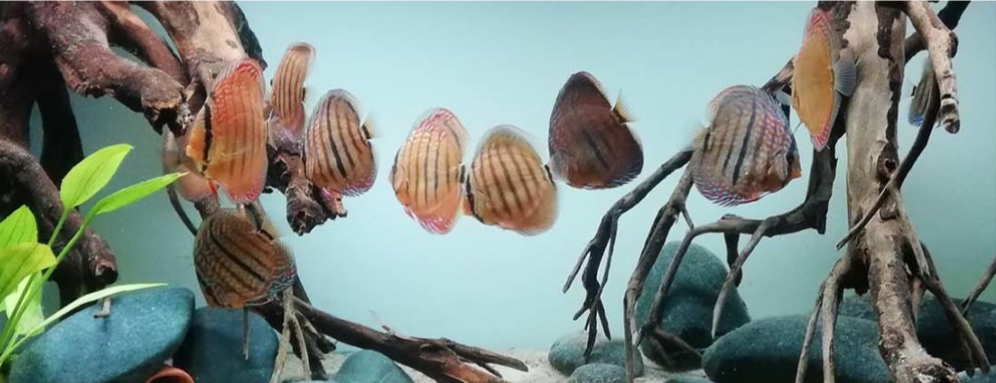


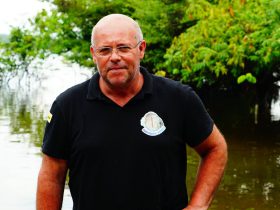


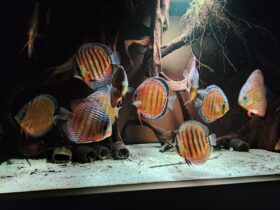



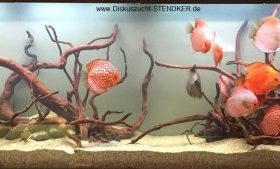
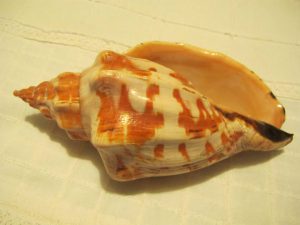
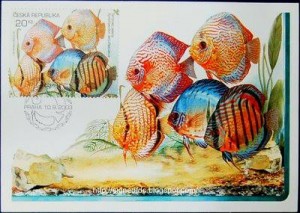








Like!! Really appreciate you sharing this blog post.Really thank you! Keep writing.